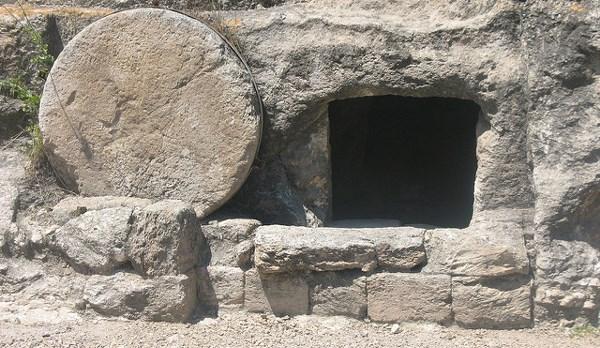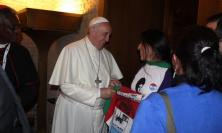‘The walls we build to protect ourselves and to keep others out all contribute to the establishment of a tomb, an abode of the dead, a hell that produces sentiments of anxiety, suspicion, fear and despair’. But the bursting forth of a new world on Easter morning breaks the walls of this tomb and opens our horizons, writes David Neuhaus SJ: ‘resurrection renews hope’.
The Cambridge Dictionary defines the word ‘horizon’ as ‘the line at the farthest place that you can see, where the sky seems to touch the land or sea’. This Easter, the word ‘horizon’ strikes me as particularly appropriate in order to understand what difference Jesus’s resurrection makes in my life and in our world.
Christ’s victory over death is first noted in the gospel when the women approach the tomb early on Sunday morning. They have come reverentially to anoint Christ’s body, which three days earlier had been hurriedly consigned to a tomb. A heavy stone had been rolled over the mouth of the burial cave, as was common practice, and the Jews, those who were his disciples and those who were his opponents, then observed the Sabbath. In the silence of the Sabbath, a new world, whose seed was conceived in Christ’s crucified body, was mysteriously being formed. This new world would burst forth on the first day of the week, the first day of a new creation. It is into this world that we, disciples of Christ, are invited. It is to this new world that we, disciples of Christ, point with our witness.
As the women approached the tomb, as yet unaware of the new world that awaited them, they asked ‘Who will roll away the stone for us from the entrance to the tomb?’ (Mark 16:3) Still firmly rooted in the world that is passing away, their anxiety, sadness and sense of loneliness are all present in this question. Jesus has left them alone and they live this as an abandonment with a profound sense of grief. Yet all this gives way to bewilderment, confusion and fear as they gaze on the tomb, burst open, and on the heavy stone, pushed aside. Mark’s Gospel concludes the scene with the troubling words, ‘So they went out and fled from the tomb, for terror and amazement had seized them; and they said nothing to anyone, for they were afraid’ (Mark 16:8). It is this that must become wonder, joy and thanksgiving as the women, first witnesses of the resurrection, encounter the Risen Jesus.
What distinguishes the old world from the new one? That is a difficult question to answer as we are still living so much in the old. At the Last Supper, Jesus prayed to his Father for his disciples, saying: ‘I am not asking you to take them out of the world, but I ask you to protect them from the evil one. They do not belong to the world, just as I do not belong to the world’ (John 17:15-16). Indeed, our being in the old world that has still not passed away makes our fidelity to the new world, into which we are invited by Jesus, fragile and sometimes faltering. The new often loses its specific character, its contours blur and its distinct character dissolves as our rootedness in the old overshadows the light of the new.
It is the word ‘horizon’ that distinguishes the old world from the new. Whereas the old world is suffocating, dark and often hopeless, provoking anxiety and sadness, the new world is one in which horizons are open, flooded with light and joy, evoking hope. Death is the reality of the old world, a reality where the horizon is blocked; and resurrection is the reality of the new, where the horizon stretches to where heaven and earth touch.
The dead body of Jesus was laid in a tomb, dark, dank and closed in. Jesus really died! He did not pass through death or act dead, but he truly died as a human being dies. His death, burial and descent into the place of the dead constitute an essential element in his birth, death and resurrection. In the Apostles’ Creed, we recite a summary of the Easter Triduum: ‘[He] suffered under Pontius Pilate, was crucified, died and was buried; he descended into hell; on the third day he rose again from the dead’. Many have struggled to understand what it means for Jesus, after his death on the cross, to have descended into hell. This is a reference to passages in the New Testament that talk of a descent into the kingdom of the dead after the death of Christ. Most explicitly this is referred to in 1 Peter 3:18-19: ‘For Christ also suffered for sins once for all, the righteous for the unrighteous, in order to bring you to God. He was put to death in the flesh, but made alive in the spirit, in which also he went and made a proclamation to the spirits in prison’. In Hebrew, the place referred to as ‘hell’ and described as a ‘prison’ is called Sheol, the abode of the dead.
Sheol in the Old Testament is described as a dark and suffocating place under the earth. In the terrifying story of Korah, Dathan and Abiram, who challenged the leadership of Moses, they were swallowed up by the earth that opened its mouth, and ‘closed over them’, bringing them into Sheol (Numbers 16:30–33). Isaiah spoke of Sheol as a place of imprisonment behind gates (Isaiah 38:10), the Book of Job describes it as a place behind bars (Job 17:16) and the Psalm describes cords and snares that entangle (Psalm 18:5). Elsewhere, Isaiah spoke of Sheol as a place of darkness, a land where there is no memory (Isaiah 14:9, 26:14) like in the Psalms, which describes it as ‘darkness… the land of forgetfulness’ (Psalm 88:12). Solomon describes a place of inactivity, where there is no work and no thought (Ecclesiastes 9:10). It is a place of silence (Psalm 115:17). Most characteristically, Sheol is a place where there is no praise of God. ‘For in death there is no remembrance of you, in Sheol who can give you praise?’ (Psalm 6:5). ‘For Sheol cannot thank you, death cannot praise you; those who go down to the Pit cannot hope for your faithfulness’ (Isaiah 38:18).
Jesus experiences the reality of the tomb and that of Sheol as an essential part of the incarnation through which he enters fully into our human lives. The reality of the tomb is a human reality we fully know in death. However, before we die, we can and often do choose death over life over and over again. We are enslaved to the consequences of our wrong choices. In these choices, the tomb is palpable, a reality of darkness, sin and fear. It is this exit from a place of imprisonment and slavery that the Jewish people celebrate at Passover. Their exit from Egypt is a breaking out of the prison of slavery. The word for Egypt in Hebrew (Mitzrayim) evokes the word for narrow and confining (tzar). It is thus completely coherent that Jesus the Jew chose the Passover as the time to pass from death to life. At Easter, we are invited to renew our commitment to the new world born from the tomb. We are called to burst out of the tomb into life, leaving behind us a tomb that is empty.
The tomb reality is one of walls, the blocking out of light, lack of vision, a place in which there are no horizons. Saint Teresa of Avila described a vision of hell in these words:
Being in such an unwholesome place, so unable to hope for any consolation, I found it impossible either to sit down or to lie down, nor was there any room, even though they put me in this kind of hole made in the wall. Those walls, which were terrifying to see, closed in on themselves and suffocated everything. There was no light, but all was enveloped in the blackest darkness.
Scripture and the saints teach us that Sheol is not just a matter of human destiny. There is a choice involved, between stagnating in a place where all the horizons are shut off with walls or tending towards a place where the horizon is stretching out before us.
The world we often choose to live in resembles Sheol in more than one sense. The walls we build to protect ourselves and to keep others out, the language we mouth to define our ‘us’ against our ‘them’, the resources we spend in order to keep track of who is our ‘us’ and who is our ‘them’, all contribute to the establishment of a tomb, an abode of the dead, a hell that produces the sentiments of anxiety, suspicion, fear and despair that accompany us too often. This Sheol, which we call home, is ever more alive as a discourse of phobia resounds in our capitals, building on a sentiment of fear.
The old world is often our world, a world that encourages apathy in the face of the misery produced by our greed. As we shut the door in the face of our brothers and sisters who clamour for our solidarity and assistance, we sink into the tomb. As we watch unmoved as millions flee their homes because of hunger and war, petrifying our hearts with suspicion and refusal, we adopt the constitution of an old world that crucified Jesus. As we comfortably mouth a language that divides the world into ‘friends’ and ‘enemies’, we betray a gospel that preaches love and pardon. And so we sink into a hopelessness that proposes the walls we build around ourselves in brick and word, in violence and rejection. Resurrection renews hope. The walls crumble. In a Twitter message on 9 February 2017, Pope Francis proclaimed ‘Hope opens new horizons and enables us to dream of what is not even imaginable’. Hope enables us to quit the old world on Easter morning!
Pope Francis, great apostle of the new world, spoke out loud and clear in favour of the new world in his inaugural homily as pope on 19 March 2013:
Saint Paul speaks of Abraham, who, ‘hoping against hope, believed’ (Rom 4:18). Hoping against hope! Today too, amid so much darkness, we need to see the light of hope and to be men and women who bring hope to others. To protect creation, to protect every man and every woman, to look upon them with tenderness and love, is to open up a horizon of hope; it is to let a shaft of light break through the heavy clouds; it is to bring the warmth of hope! For believers, for us Christians, like Abraham, like Saint Joseph, the hope that we bring is set against the horizon of God, which has opened up before us in Christ. It is a hope built on the rock which is God.
A few months later, on his visit to the tomb of Christ, in May 2014, Pope Francis expressed this reality of a new world outside the tomb. The context of his words was the meeting with the Orthodox Patriarch of Constantinople. His words, however, stretch far beyond that specific context.
We need to believe that, just as the stone before the tomb was cast aside, so too every obstacle to our full communion will also be removed. This will be a grace of resurrection, of which we can have a foretaste even today. Every time we ask forgiveness of one another for our sins against other Christians and every time we find the courage to grant and receive such forgiveness, we experience the resurrection! Every time we put behind us our longstanding prejudices and find the courage to build new fraternal relationships, we confess that Christ is truly risen!
When Jesus bursts out of the tomb, he leads us forth into a new world, a world of open horizons. Isaiah contrasts this new world of life to that of Sheol, as a place of joyful thanksgiving: ‘The living, the living, they thank you, as I do this day; parents make known to children your faithfulness’ (Isaiah 38:19). In bursting out of the tomb, Jesus brings down walls, opens doors and brings the widest horizons into view. As the walls dissolve and the gates are burst open, one can breathe in the air of freedom and walk heads held high, no longer slaves. Thus is accomplished in the promise that God makes at the centre of the Law of Moses:
I will place my dwelling in your midst, and I shall not abhor you. And I will walk among you, and will be your God, and you shall be my people. I am the Lord your God who brought you out of the land of Egypt, to be their slaves no more; I have broken the bars of your yoke and made you walk erect. (Leviticus 26:11-13)
Fr David M. Neuhaus SJ serves as Latin Patriarchal Vicar within the Latin Patriarchate of Jerusalem. He is responsible for Hebrew-speaking Catholics in Israel as well as the Catholic migrant populations. He teaches Holy Scripture at the Latin Patriarchate Seminary and at the Salesian Theological Institute in Jerusalem and also lectures at Yad Ben Zvi.






